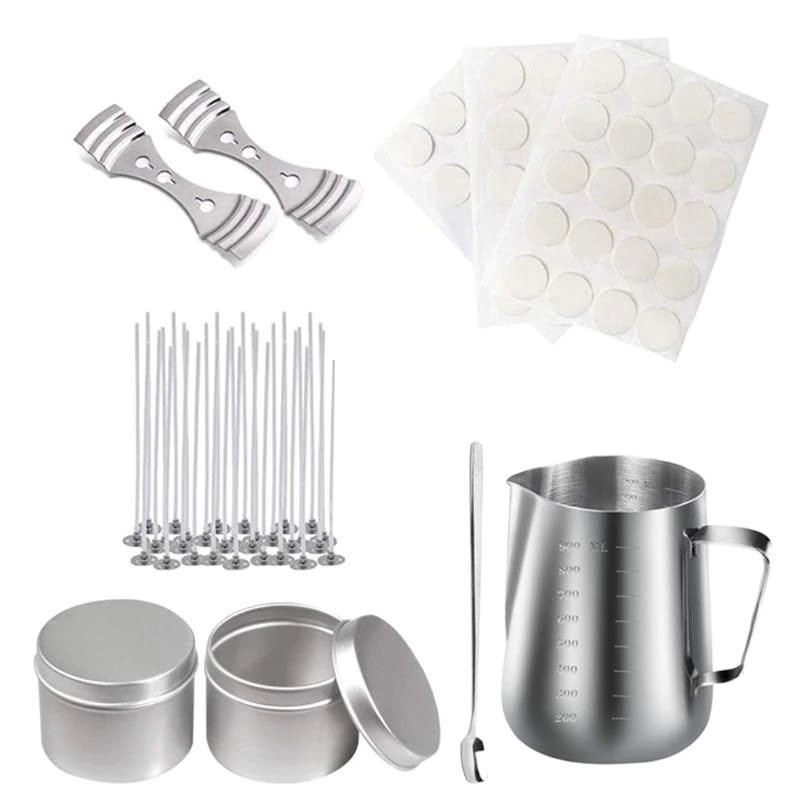Are you interested in making scented candles without essential oils? While essential oils are a popular choice for adding fragrance to candles, there are many reasons why you might want to explore alternative options. Whether you have sensitivities to certain essential oils or simply want to experiment with unique and non-traditional scents, there are plenty of ways to create beautifully fragranced candles without using essential oils.
One of the key benefits of making scented candles without essential oils is the opportunity to tap into a wide range of natural fragrance sources. From herbs and spices to citrus zest and fruit peels, there are countless ingredients that can be used to infuse your homemade candles with delightful aromas. In this article, we will explore the common alternatives to essential oils for scented candles and provide you with DIY recipes tailored specifically for non-essential oil scents.
In addition to the creative aspect of embracing non-traditional fragrances, making scented candles without essential oils can also offer aromatherapy benefits. The unique scents derived from natural sources can have a powerful impact on mood and well-being, providing an additional layer of enjoyment beyond simply creating a pleasant aroma. Whether you’re looking to reduce stress, improve focus, or promote relaxation, non-essential oil scented candles can be tailored to suit your specific needs.
Want to learn more about how you can create your own custom fragrances for homemade candles? Keep reading as we delve into the world of non-essential oil candle making.
Common Alternatives to Essential Oils for Scented Candles
When it comes to making scented candles without essential oils, there are plenty of common alternatives that can be used to create beautiful and aromatic candles. These alternatives provide a natural and non-traditional approach to candle making, offering unique scents and benefits that can enhance the ambiance of any space.
Here are some common alternatives to essential oils for scented candles:
- Fragrant Herbs: Herbs like lavender, rosemary, and mint can be used to add a natural fragrance to your candles. Simply crush or chop the herbs and mix them into the melted wax before pouring it into the container.
- Spices: Cinnamon, cloves, and nutmeg are popular choices for creating warm and comforting scents in candles. Ground spices can be added directly to the melted wax to infuse the candle with their fragrance.
- Citrus Zest: The zest of citrus fruits like lemons, oranges, and limes can add a bright and invigorating scent to your candles. Simply grate the zest into the melted wax and allow it to infuse before pouring.
These natural alternatives not only provide a pleasant aroma but also offer unique benefits such as promoting relaxation, improving focus, or boosting energy levels. Embracing these non-traditional fragrance sources opens up a world of creative possibilities for homemade scented candles.
Natural Fragrance Sources
When it comes to making scented candles without essential oils, natural fragrance sources such as herbs and spices can be your best friend. These ingredients not only add a lovely aroma to your candles, but they also bring a touch of nature into your home. Let’s explore how you can utilize herbs and spices for creating delightful non-essential oil scented candles.
Herbs for Natural Fragrance
Herbs like lavender, rosemary, peppermint, and thyme are popular choices for adding natural fragrance to homemade candles. These aromatic herbs not only offer a pleasant scent but also provide therapeutic benefits. For instance, lavender is known for its calming properties, while rosemary can help improve focus and concentration.
Spices for Aromatic Candles
Spices such as cinnamon, cloves, nutmeg, and cardamom can infuse your candles with warm and comforting aromas. The spicy notes from these ingredients create a cozy atmosphere in any room. Plus, their rich scents are perfect for the fall and winter seasons when you want to create a snug and inviting ambiance in your home.
Blending Herbs and Spices
For more complex fragrances, consider mixing different herbs and spices together. Experiment with various combinations to find the perfect blend that appeals to your senses. Creating custom fragrance blends using natural ingredients allows you to personalize your non-essential oil scented candles according to your preferences.
By harnessing the power of herbs and spices, you can make scented candles without essential oils that are just as aromatic and beneficial. With the wide range of options available from nature’s pantry, there is no limit to the delightful fragrances you can create for your homemade candles.
Using Citrus Zest and Fruit Peels for Scented Candles
Fresh and fruity scents can add a delightful aroma to your home, and using citrus zest and fruit peels is a great way to create scented candles without essential oils. These natural ingredients not only provide a refreshing fragrance but also add a unique touch to your homemade candles. Citrus zest and fruit peels are readily available in most households, making them an accessible and cost-effective alternative for creating scented candles.
When using citrus zest and fruit peels for scented candles, it’s important to prepare them properly to extract their aromatic oils. One method is to carefully remove the colored outer layer of the fruit with a zester or grater, being cautious not to include the bitter white pith beneath.
The zest can then be added directly into the melted wax while making the candles or infused into the wax beforehand for a stronger scent. Fruit peels can also be dried and ground into a fine powder before adding them to the wax for a longer-lasting fragrance.
Here are some popular citrus options for creating non-essential oil scented candles:
- Lemon: Provides a fresh and uplifting aroma that can help boost mood and energy levels.
- Orange: Offers a sweet and tangy scent that is known for its calming properties.
- Grapefruit: Delivers a zesty and invigorating fragrance that can promote relaxation and mental clarity.
By utilizing citrus zest and fruit peels in your candle-making process, you can enjoy the benefits of natural aromas without relying on essential oils. This eco-friendly approach not only reduces dependence on synthetic fragrances but also adds an element of creativity and resourcefulness to your candle-making endeavors.
DIY Scented Candle Recipes Without Essential Oils
Making scented candles without essential oils can be an enjoyable and creative process that opens up new possibilities for fragrance combinations. While essential oils are commonly used in candle-making, there are several alternative options for creating beautifully scented candles without using essential oils. By incorporating natural fragrance sources such as herbs, spices, citrus zest, and fruit peels, you can customize unique and aromatic candles to suit your preferences.
One common alternative to essential oils for scented candles is to use dried herbs and spices. Herbs like lavender, rosemary, and mint can impart a fresh and soothing scent to your candles, while spices such as cinnamon, cloves, and cardamom add warmth and richness. These natural ingredients not only provide fragrance but also add visual interest to the candles when they are incorporated into the wax or sprinkled on top as decoration.
Another option for making scented candles without essential oils is to utilize citrus zest and fruit peels. The vibrant oils found in citrus peels can infuse the wax with a bright and invigorating aroma. Whether you choose to incorporate lemon, orange, grapefruit, or lime zest into your candles, the result will be an uplifting and refreshing scent that can uplift the atmosphere of any space.
In addition to using these alternative fragrances for scented candle-making, it’s also important to consider the other components of the candle such as the wick and wax. Choosing the right wick size and type of wax is crucial in ensuring that your non-essential oil scented candles burn evenly and emit optimal fragrance. By understanding how different wicks and waxes interact with various fragrances, you can create high-quality candles that showcase your favorite non-traditional scents.
Aromatherapy Benefits of Non-Essential Oil Scented Candles
There are many benefits to making scented candles without essential oils, particularly when it comes to aromatherapy. While essential oils are commonly used for their therapeutic properties, there are other natural fragrance sources that can provide similar aromatherapy benefits.
For instance, using herbs and spices such as lavender, rosemary, cinnamon, and peppermint can create a calming or invigorating atmosphere depending on the scent used. These natural ingredients can have a positive impact on mood and emotions when the candle is lit.
In addition to herbs and spices, citrus zest and fruit peels can also be utilized to add a refreshing and uplifting scent to candles. Lemon, orange, and grapefruit peels can contribute a bright and energizing aroma to the space where the candle is burned. The use of these natural fragrances in non-essential oil scented candles opens up a world of possibilities for creating unique and personalized aromatherapy experiences in the home.
When creating DIY scented candle recipes without essential oils, it’s important to consider the specific aromatherapy benefits that each natural fragrance source provides. This allows for the intentional selection of scents based on their desired effects. For example, using chamomile or jasmine for relaxation, or eucalyptus or tea tree for respiratory support. Understanding the therapeutic properties of different herbs, spices, and citrus fruits is key to harnessing their full aromatherapy potential in non-essential oil scented candles.
| Aromatherapy Benefits | Natural Fragrance Sources |
|---|---|
| Calming | Lavender |
| Invigorating | Peppermint |
| Energizing | Citrus Zest (e.g. lemon) |
Tips for Choosing the Right Wick and Wax for Non-Essential Oil Scented Candles
Understanding Wick and Wax Compatibility
When making scented candles without essential oils, it’s important to consider the compatibility of the wick and wax. Different waxes require different types of wicks to ensure proper burning and fragrance dispersion. For example, soy wax typically requires a cotton or cotton-paper blend wick, while beeswax works best with a pure cotton wick. It’s essential to research and test different combinations to find the right match for your non-essential oil scented candles.
Choosing the Right Wick Size
The size of the wick also plays a crucial role in how well your non-essential oil scented candle will burn. If the wick is too small, it may not create a wide enough melt pool, causing tunneling and poor fragrance throw.
On the other hand, a wick that is too large can lead to excess smoking and soot. It’s recommended to start with the wick size recommended by your wax supplier and adjust as needed based on your specific fragrance and container size.
Finding Non-Toxic Options
In addition to considering compatibility and size, it’s essential to choose wicks and waxes that are as non-toxic as possible. Look for natural, untreated wicks made of pure cotton or other sustainably sourced materials. When selecting wax, opt for options that are free from additives and synthetic chemicals. By prioritizing non-toxic materials for your non-essential oil scented candles, you can create a healthier and more environmentally friendly product for yourself and your customers (if selling).
Conclusion
In conclusion, making scented candles without essential oils opens up a world of possibilities for unique and non-traditional fragrance options. By exploring natural fragrance sources such as herbs, spices, citrus zest, and fruit peels, candle makers can create one-of-a-kind scents that go beyond the typical essential oil offerings. These alternative ingredients not only add a delightful aroma to the candles but also bring in an element of creativity and innovation to the process.
Furthermore, DIY enthusiasts can experiment with various combinations of non-essential oil fragrances to create their own personalized scent blends. Whether it’s the calming effect of lavender and chamomile or the invigorating aroma of citrus and mint, there are endless opportunities to customize scented candles according to individual preferences. This freedom to mix and match different natural ingredients allows for a truly unique sensory experience that cannot be achieved with essential oils alone.
Lastly, embracing non-traditional scented candle making with essential oil-free fragrances not only offers diversity in scent choices but also opens up new avenues for those who may be sensitive to essential oils. With the right selection of wick and wax, non-essential oil scented candles can provide long-lasting fragrance and offer aromatherapy benefits without triggering any adverse reactions.
Ultimately, venturing into this non-traditional approach to candle making allows for greater creativity, personalization, and inclusivity within the craft.
Frequently Asked Questions
How Can I Scent Something Without Essential Oils?
There are several ways to scent something without using essential oils. One method is to use herbs, spices, or dried flowers as natural fragrances. Another option is to use fragrance oils, which are synthetic but still offer a wide range of scents.
What Can You Use to Scent Candles Other Than Essential Oils?
If you’re looking for alternatives to essential oils for scenting candles, consider using fragrance oils specifically designed for candle-making. These oils come in a variety of scents and are specifically formulated to work well with wax, providing a strong and long-lasting aroma.
Do You Need Essential Oils to Make Candles?
While essential oils are commonly used to make candles due to their natural fragrance and aromatherapy benefits, they are not the only option. Candle-making can also be done using fragrance oils or other natural materials like herbs and spices to create beautiful, aromatic candles without relying on essential oils.

Welcome to my candle making blog! In this blog, I will be sharing my tips and tricks for making candles. I will also be sharing some of my favorite recipes.





